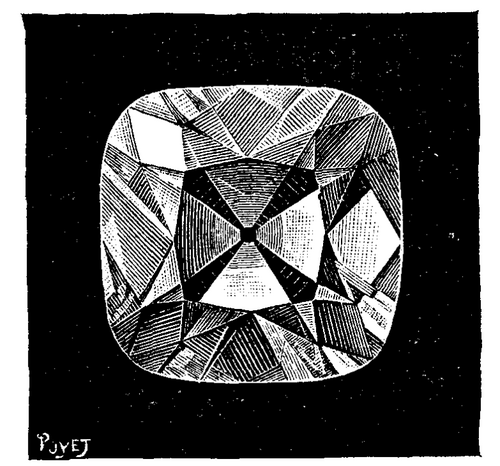The Crown Diamonds Of France
Description
This section is from "Scientific American Supplement". Also available from Amazon: Scientific American Reference Book.
The Crown Diamonds Of France

Fig 1
THE CROWN DIAMONDS OF FRANCE AT THE EXHIBITION OF INDUSTRIAL ARTS.
According to a recent law of Parliament, a large part of the crown jewels of France is destined to be sold. The exhibit that has been made of these riches for the last two months at the National Exhibition of the Industrial Arts, in the State Hall of the Louvre, has excited a lively interest among the visitors. Here are to be seen, heaped up in a large octagonal show-case, incomparable treasures, whose value exceeds quite a number of millions. According to the inventory of 1818, the 52,000 precious stones of the crown of France were estimated as worth more than 20 million francs ($4,000,000); but since that epoch the stones have increased in number, and money has singularly diminished in value, so that the total at present would be much less.

FIG. 2. - THE REGENT. (Actual Size.)
In order to publicly exhibit so valuable treasures it was necessary to take precautions against thieves and fire, and this was done in a very sure and ingenious manner. The collection of crown jewels is distributed over the eight faces of an octagonal truncated cone, which is supported by a framework about three feet in height at the lower part. The stand is exhibited every day, at ten o'clock in the morning and six in the evening, under an elegant octagonal show-case surmounted by a high bronze statue of Fortune by Barbedienne. The whole is covered with a canopy, as shown in Fig. 1.
A force of guardians of the Treasury is detailed to watch over the crown jewels, and it is to them that is confided the care of operating in the morning and evening the safety mechanism that we shall describe. The object of this mechanism is to lower into and lift out of the strong-box the entire stand with all its jewels.
A winch, shown at A to the right of the engraving, sets in motion a system of gear wheels keyed at an angle, at B and C, upon intermediate shafts that transmit motion to the four vertical threaded rods of the frame, D. All these shaftings are 1½ inch in diameter, and the cog-wheels, twenty in number, are about 5 inches in diameter.
The well is formed of an octagonal wall of fire-brick, and is 20 inches thick and 6 feet high. In the center of this masonry is embedded very thick iron plate. The bottom of the well is isolated from the flooring of the Exhibition hall by a thickness of boiler plate, by a filling of tire bricks, and finally by a second thickness of boiler plate. The well is closed by means of a large plate of iron 6 inches thick, 10 feet in length, and 88 feet in width. The winch which maneuvers this mass is placed at E. It actuates a system of bevel wheels, keyed at F, which transmit motion to two horizontal screws (hidden under the stage) that actuate the plate, H. This latter is provided with two parallel series of five rollers each that revolve over long and strong pieces of wood covered with rails. Electric alarms are located near the winches.
A fire-engine station is located at within twelve or fifteen feet of the exhibition building.
A committee composed of competent jewelers and mineralogists has been appointed to make an appraisement of the diamonds and to indicate such as should be withheld from sale on account of their scientific, artistic, or historic interest. The members of the committee propose to preserve the following objects:
1. The "Regent" (Fig. 2), by reason of its mineralogical value, the perfection of its cutting, the purity of its water, its incomparable luster, and its great size, it being the largest brilliant as yet known.
2. The military sword of Charles the Tenth's coronation, the hilt of which is entirely of brilliants mounted by Bapst with wonderful art.
3. The jewel called the "Reliquary," of the 15th century.
To these riches must be added the following interesting objects: the Dey of Algiers' watch; the Elephant of Denmark; the decorations, etc., of foreign orders; crowns and diadems of sapphire; rubies; pearls that afford curious specimens of French art at the beginning of our century; one of the Mazarins bequeathed by the celebrated Cardinal; and lots of colored stones destined for our national museums.
The same exhibition alluded to above contains a number of other collections of great interest that it would be unjust to pass over in silence, such as the exhibit of the French diamond mines of the Cape, where one may see all the details of this prosperous exploitation by means of photographs and specimens. The art bronzes, the objects of jewelry, of goldsmith's work, and of morocco work, the music boxes, Trouve's and Aboilard's electric jewelry, and the retrospective art collections especially attracted the attention of the public. - La Nature.
Continue to:


